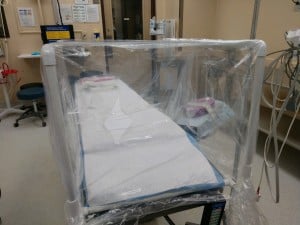Regional One Health’s Center for Innovation is celebrating employees who are adapting to the challenges of COVID-19 by coming up with new ways of helping their patients and colleagues.
Certified Registered Nurse Anesthetist Frank Williams developed a tent that can be used to protect providers from particles that become airborne during airway procedures like intubations.
With the help of the innovation center, his invention is being tested and improved for use not only during the pandemic, but well into the future.
Health care workers know they face additional risk during the COVID-19 pandemic, and they’re willing to accept that to help patients in need. But if they can add layers of protection to keep themselves and their colleagues safe, they’re eager to do so.
That philosophy drove members of Regional One Health’s anesthesiology department to find a way to protect providers during airway procedures.
Frank Williams, CRNA, and Mary Farris-Conley, CRNA, responded to a call to develop an intubation aerosol shield that creates a physical barrier between the patient and provider without hampering the provider’s ability to render care. Armed with some PVC pipe, plexiglass, plastic sheeting and a mental vision of what was needed, Williams got to work.
“Everyone here at work sees me as the handyman,” he laughed. “I have a farm and I work on my own farm equipment, so I’ve always been kind of a jack-of-all-trades.”
He embraced the chance to put those skills to work for his fellow health care workers.

Certified Registered Nurse Anesthetist Frank Williams created an intubation shield that protects providers during airway procedures, when particles are likely to become airborne.
Certified registered nurse anesthetists are involved in airway procedures like intubating patients for surgery and emergency care. These procedures cause respiratory droplets to become airborne, creating the risk of exposure to COVID-19.
Williams started by using PVC pipe and plexiglass to create a box to cover a patient’s head and neck, but the rigid material proved too cumbersome. It was also hard to accommodate providers and patients of different sizes, and to run tubes and wires that connect patients to equipment.
As Williams continued to refine his design, officials at the Elvis Presley Trauma Center were looking for a similar device to use with shock trauma patients. After seeing Williams’ prototype, director of nursing Charles Lapsley, MSN, RN and patient care coordinator Kerry Lyons, RN, PCC, submitted it to the Center for Innovation for support with development and testing.
Alejandra Alvarez, Center for Innovation director, said her team was excited to use its expertise to test, refine and scale his product.
“He took a challenge and used existing items to put together a viable product we could test right away,” she said.
“Our role was to support them to scale the idea in a way that could be tested for feedback in a real-life environment. We were able to help him scale and guide the team to test it within the right regulations and appropriate documentation and precautions.”
The innovation center helped with training materials, user guides, etc. to ensure both patient safety and productive testing. They helped Williams create “version 2.0” of the product that is more user-friendly and performs better during medical emergencies.

Alejandra Alvarez, director of the Center for Innovation, was excited to help Williams refine his invention: “We were able to help him scale and guide the team to test it within the right regulations and appropriate documentation and precautions.”
“We came up with a design that drapes over the patient and allows their head and upper chest to be fully enclosed, with arm holes that are flexible enough to fit different practitioners,” he said. “Most importantly, it provides rapid access to the patient in an emergency.”
With the Center for Innovation’s support, providers started testing Williams’ model. “We use it anytime we have a chance,” he said. “The more we do it, we get more familiar with it and generate ideas for improvements.”
Based on the feedback, Williams has developed ways to make the tent even more protective for providers and continues tweaking his design to make it more effective and user-friendly. But overall, “People who have used it said they had no problems with it. They’re glad to have it as a tool when they’re treating patients who have tested positive for COVID-19.”
Providers plan to continue using the tent with COVID-19 patients, and they also see applications beyond the pandemic. “COVID-19 isn’t going away soon, and we think there are multiple uses during the pandemic – for example, we’re looking at using this while transporting patients within the hospital,” Williams said. “In the future, it can be used with any patient who needs to be isolated, such as for tuberculosis or another condition where you need to open the airway.”
Alvarez agrees, noting the intubation tent has applications for any illness spread by airborne particles. She said the Center for Innovation looks forward to continuing the collaborative effort to create the most effective product possible.
“As you expand an innovation, there are more needs in terms of protocols and approvals, plus the need for more input from subject matter expertise such as engineering,” she said. “We’ll provide that support, and we hope to bring in engineering partners to help expand or advance the device.”
And to think it all started with some simple materials, a spirit of innovation and a dose of good old-fashioned handyman skills. “Just like we wear a mask to prevent particles from spewing when we cough or sneeze, the tent keeps virus and bacteria from becoming airborne,” Williams explained. “It’s one more layer of protection that can be manufactured easily and inexpensively.”

